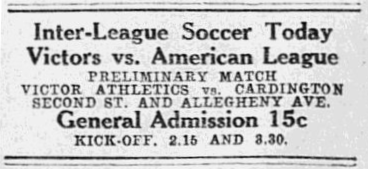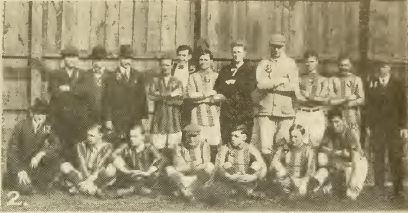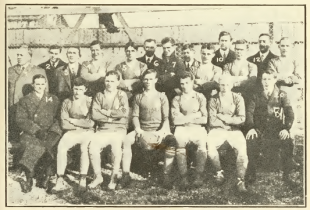Featured image: Bethlehem Steel, 1913-14
There was a great deal of news for Philadelphia soccer fans before the start of league play on Oct. 4, 1913.
Belmont Cricket Club, holders of the Mannheim Prize, — the Cricket Club league championship trophy that is still played for today — for four-seasons running and so important to the rejuvenation of the soccer locally through their hosting of the first international friendly in Philadelphia in 1901, moved across the river to Merchantville in New Jersey and would now play under that name after their West Philadelphia grounds had been bought by the city for the recreation center that stands to this day between 49th and 51st streets and Chester and Kingsessing Avenues.
Meanwhile, teams continued to play warmup games ahead of the start of league play. On Sept. 20, American League champions Boys’ Club was soundly defeated by Kensington of the Allied American League, 4-1. The Inquirer reported on Sept. 21 that the league champions lost the game through poor play in the first half. “Had Boys’ Club played as well in the first period as the did in the second the result might have been different but as it was Kensington started in to do things right at the start, and before the Boys’ Club awoke to the fact they were practically defeated.”
The Boys’ Club’s lone goal was scored by Walter Burgin who, along with teammate and future National Soccer Hall of Famer Dick Spalding, would represent the United States in Scandinavia in its first international tour in 1916.
On Sept. 27, Allied League champions Bethlehem FC — who were not yet known as Bethlehem Steel FC — defeated Reading, 3-0. The Inquirer reported on Sept. 28, “The Bethlehemites showed a consistent combination, and did some thrilling passing.” With Reading “seldom penetrating the locals defense,” it was only the strong play of Reading goalkeeper Carter “that prevented Bethlehem from piling up more goals.”
 The final big warmup game of the preseason featured Victor, owned by local bottling magnate Fred Bientzle and a member of the city’s professional Pennsylvania League, against a picked team representing the amateur American League at the grounds at Second and Allegheny on Sept. 27. Victor won handily, defeating the American Leaguers 3-1. Former Tennyson forward Tommy Gaynor scored the hat trick for Victor.
The final big warmup game of the preseason featured Victor, owned by local bottling magnate Fred Bientzle and a member of the city’s professional Pennsylvania League, against a picked team representing the amateur American League at the grounds at Second and Allegheny on Sept. 27. Victor won handily, defeating the American Leaguers 3-1. Former Tennyson forward Tommy Gaynor scored the hat trick for Victor.
The Inquirer’s verdict on the game was one that has probably been familiar since the beginning of the sport 50 years earlier. “Their victory was due to their forwards taking advantage of every opportunity that came their way, while the front line of the amateurs failed to shoot when they had the chance, dallying on the ball on several occasions when in close proximity to goal.”
Opening day
The opening of league play on Oct. 4 saw twenty games across the Pennsylvania League, the three divisions of the Allied League, the American League, the United League, and the Philadelphia Junior League. Not every team in the leagues played on opening day and at least two leagues, the Cricket Club League and the Northeast Junior League, would start play later.
In the Pennsylvania League, Wissinoming managed to hold league champion’s Hibernian scoreless for 65 minutes before their defense collapsed and Hibs ran off as the 4-0 winners. Future National Soccer Hall of Famer Tommy Swords scored Hibs’ second goal. Victor continued their good preseason form with a 5-2 thumping of league stalwarts Tacony at Tacony Ball Park at State Road and Unruh Street.
Only one game took place in the nine-team Allied League first division, with league champions Bethlehem and the strong West Philadelphia side among those with the weekend off. In the sole first division fixture of the day, Smith Athletic Association defeated Peabody, 2-1. The Peabody club was run by Oliver Hemingway, who, in addition to helping run the Allied League, had been instrumental in the founding of the United States Football Association, now known as the United States Soccer Federation, and had been named its first vice president in June.
All eight clubs of the Allied League second division played on Oct. 4. The second division roster of teams underscored the geographic reach of the the league, which in the first division, in addition to Bethlehem, included Reading and the Wilmington Irish-Americans. In the second division, the home grounds of Linwood Hibernians was located at Third Street and Highland Avenue in Chester. Marcus Hook FC called the grounds at Tenth and Market Street in Marcus Hook home. Windsor FC played at Shellpot Park in Wilmington.
The results of the second division fixtures underscored another point: the quality of the teams varied greatly. On opening day, the four winning clubs outscored their opponents 21 to 3, all of the losing goals coming in the 7-3 victory of Fairhill over Linwood Hibernians.
That gap in quality was also evident in the results from the American League and United League. The eight-team American League saw three games played on opening day. Philadelphia Electrics, popularly known as “the Live-Wires,” thumped Victor Athletics 5-0 while Delaware County’s Cardington FC dominated Whitehall Rovers 4-2. Remarkably, Cardington played the game with only nine men and inside right Pendlebury scored all four of their goals. The combined scorelines of those two games were equaled in Frankford Boys’ Club’s 9-2 destruction of Victoria Plush Mills.
Boys’ Club was scheduled to host Rangers FC in American League play at Frankford and Erie on opening day but the game had to be postponed. The Inquirer reported on Oct. 5 that the game was called off “owing to the fact that the baseball game which was played previously had not reached a conclusion when the time for the soccer game had arrived.”
In the fourteen-team United League, five games were played and big scorelines were again the story of the day. Kensington Boys’ Club’s 7-2 win over Bristol was bested by Roxborough’s 7-0 win over La Mott. Meanwhile, Vincome defeated Cardington Reserves 5-2.
Youth soccer in 1913
The importance of youth soccer in the development of the sport has long been recognized and things were no different in 1913. Describing the efforts of the Northeast Junior League to expand, the Inquirer wrote on Sept. 22, “It will pay those who have the interest of the future development of the game at heart to help along the Juniors as much as possible, for the rising generation will have to be catered to if we expect soccer to make the headway that it truly deserves in this country.”
While the Northeast Junior League did not commence play on Oct. 4, the Philadelphia Junior League did. In the four games played, the winners outscored the losers 23 to 4.
News came on Oct. 5 that a Boys’ Club league had been formed by the Germantown Boys’ Club Athletic Association that would be made up of eight teams, “all made up of boys who are under 18 years of age.”
The Inquirer report continued, “Arrangements have been made for the teams to practice on the Boys’ Club playground in the evenings, which will be made possible by the four large arc lamps that were recently installed and which light up the playground, so that it will be very easy for the teams to work every evening.”
The Inquirer reported that, if things went as planned, the league would start play no later than Oct. 20.



Comments